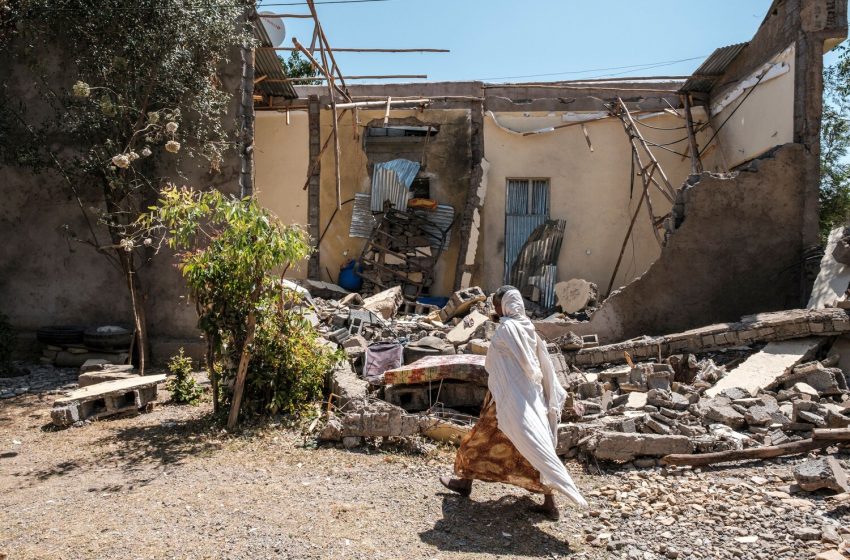
Ethiopians Are Starving in Silence
Source: Refugee International
September 24, 2021
Week after week, the Ethiopian government blockade of Tigray prevents aid agencies from moving life-saving relief of food, medicine, shelter items, fuel, and cash necessary to stop famine that continues to grow virtually uninterrupted. Today, almost a million people in northern Ethiopia are experiencing famine conditions.
Here’s what you need to know this week:
Ethiopia’s blockade of Tigray continues…
Despite protestations, the blockade put in place on June 27 continues to prevent relief assistance from entering Tigray. From September 5-7, 147 trucks of humanitarian supplies arrived in the northern Tigray region via neighboring Afar, bringing the number of humanitarian trucks that entered Tigray since July 12 to 482—a far cry from the estimated 100 trucks needed every day, or 8,700 trucks since the blockade came into effect. In addition, the blockade denies many critical supplies, including communications equipment, cash, and fuel, without which humanitarian operations cannot continue. Even personal phones, hard drives, can-openers, and multivitamins are restricted from being brought in by aid workers who manage to travel.
…and is driving and human suffering and famine.
On September 16, the United Nations Office for the Coordination of Humanitarian Affairs (OCHA) released a weekly humanitarian update, providing the latest information on the impact of Ethiopia’s blockade on Tigray. Virtually every sector was forced to suspend activities, as new reports of starvation deaths have emerged.
- Food relief aid remains suspended for a lack of supplies, cash, and trucks. Since March 27, the UN and NGOs nearly completed a three-month distribution for 5.2 million people, and with reduced supplies reached 1.4 million people in a second round. This roughly translates to four months of food for a population denied the ability to access communications, banking, or markets to support themselves.
- Access to potable water via trucking was reduced to 25 percent coverage due to shortages in cash and fuel. Insufficient or unpotable water drive disease outbreaks, particularly for those weakened by malnutrition.
- Health services are only partially functioning, with supplies for only 20 percent of the population at a time when disease outbreaks continue to rise. The European Union initiated Humanitarian Air Bridge arrived in Tigray with nutrition supplies, and the World Health Organization (WHO) airlifted supplies from Dubai for 150,000 people. While these massively expensive innovations are welcome, that they are necessary in the first place speaks volumes about the brutality of the blockade and the lengths to which the world is going to find solutions.
- Nutrition assistance for children under five was suspended for children in outpatient and in-patient care due to shortages in cash, fuel, and supplies. The UN’s World Food Programme (WFP) was quoted as saying 30 percent of children under five and 80 percent of pregnant and lactating mothers now suffer from malnutrition. This is double international emergency standards for malnutrition in children and more than 5 times emergency thresholds for nursing mothers.
Some 45 days ago, UNICEF noted, “This malnutrition crisis is taking place amid extensive, systematic damage to the food, health, nutrition, water and sanitation systems and services that children and their families depend on for their survival.” It is usually children, pregnant women, and other vulnerable groups that bear the brunt of famine. Yet, since this warning from UNICEF, it bears repeating – less than 10 percent of the needed supplies to keep people alive have been allowed entry to Tigray, months after empirical evidence proved famine conditions.
Hunger and alleged atrocities are spreading beyond Tigray.
The conflict now risks expanding into a wider civil war that threatens Ethiopia and regional stability. As the war spreads, so does hunger with the UN estimating that 1.5 million more people are food insecure in the areas where the Tigray Defense Forces (TDF) has advanced in neighboring regions of Amhara and Afar in recent weeks. Their advance includes fresh accusations of atrocities that warrant independent investigation alongside alleged crimes committed in Tigray. Active conflict has prevented UN and NGOs teams from accessing conflict-impacted areas. Historically, these areas were some of the poorest subsistence communities in the region and will require assistance in addition to the 5.5 million people FEWSNET defined as ‘in crisis’ and ‘without assistance will descend into famine’ in Tigray.
Western donors have given generously to Ethiopia for decades, pouring tens of billions of dollars into Ethiopia’s economy, heavily subsidizing Ethiopia’s budget. All told, western donors contribute at least 37 percent of Ethiopia’s budget through humanitarian, development, security, and other support. Yet their efforts to raise alarm at the avalanche of credible atrocities including war crimes, crimes against humanity, ethnic cleansing, and genocide have been met with outright rejection by Ethiopia and at the UN Security Council—with China blocking efforts to put the crisis on the Council’s agenda. Even the role of perhaps the most destructive force in this conflict—Eritrean forces (EDF)—has not been addressed by the Council. Clearly, the status quo much change.
The Biden administration is stepping up the pressure.
In the face of continued violence that continues to spiral out of control, U.S. President Biden issued an Executive Order that paves the way for a sanctions regime that can target any party responsible for prolonging the conflict in northern Ethiopia, those that commit human rights abuses, and those obstructing humanitarian access including Ethiopia’s blockade of Tigray. Given the challenges facing the population, this is a step in the right direction but must be implemented and not an idle threat to be effective.
Famine will continue to grow as the blockade impedes food aid, medical and nutrition supplies, fuel, and cash. There needs to be an immediate ceasefire and end to the blockade to ensure assistance is possible to those affected in Tigray, and now in Amhara and Afar.
PHOTO CAPTION: A woman walks in front of a damaged house in Wukro, north of Mekele, on March 1, 2021. (Photo by EDUARDO SOTERAS/AFP via Getty Images)
